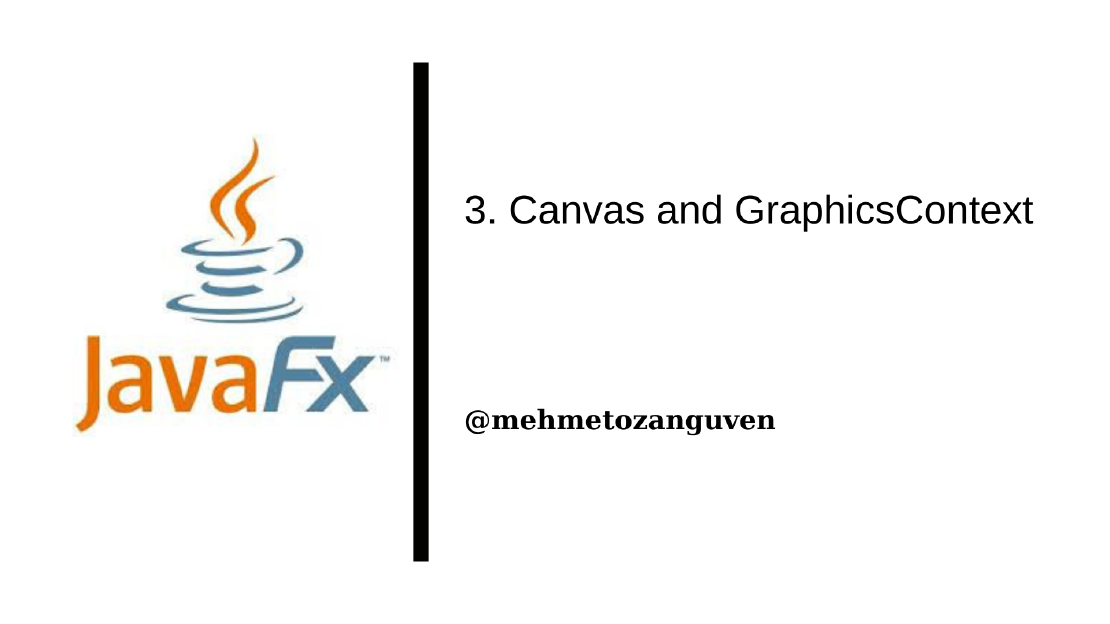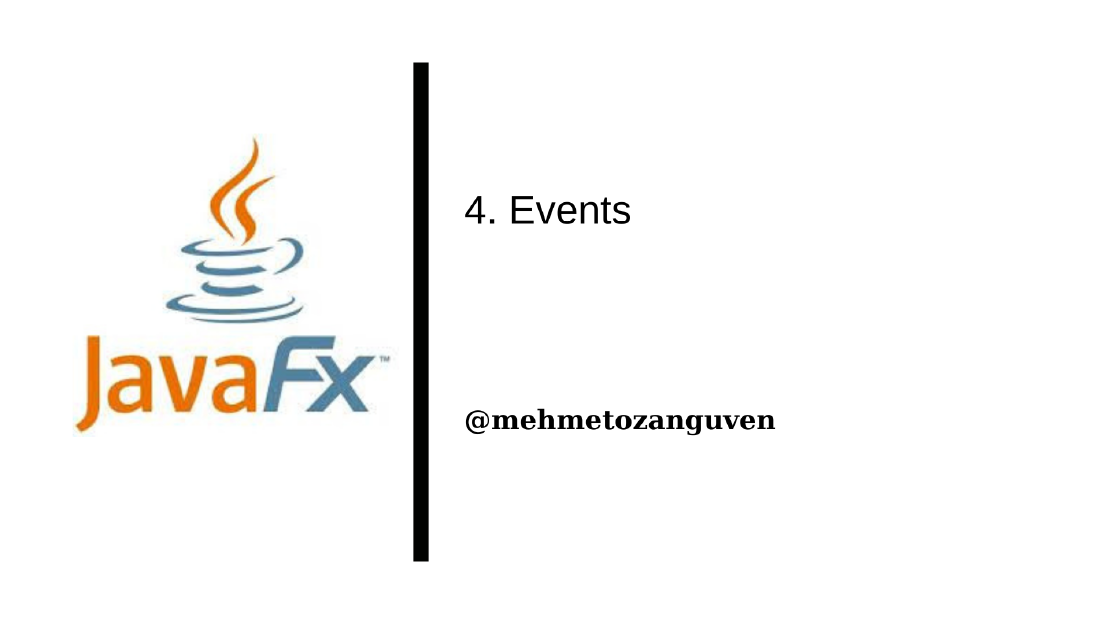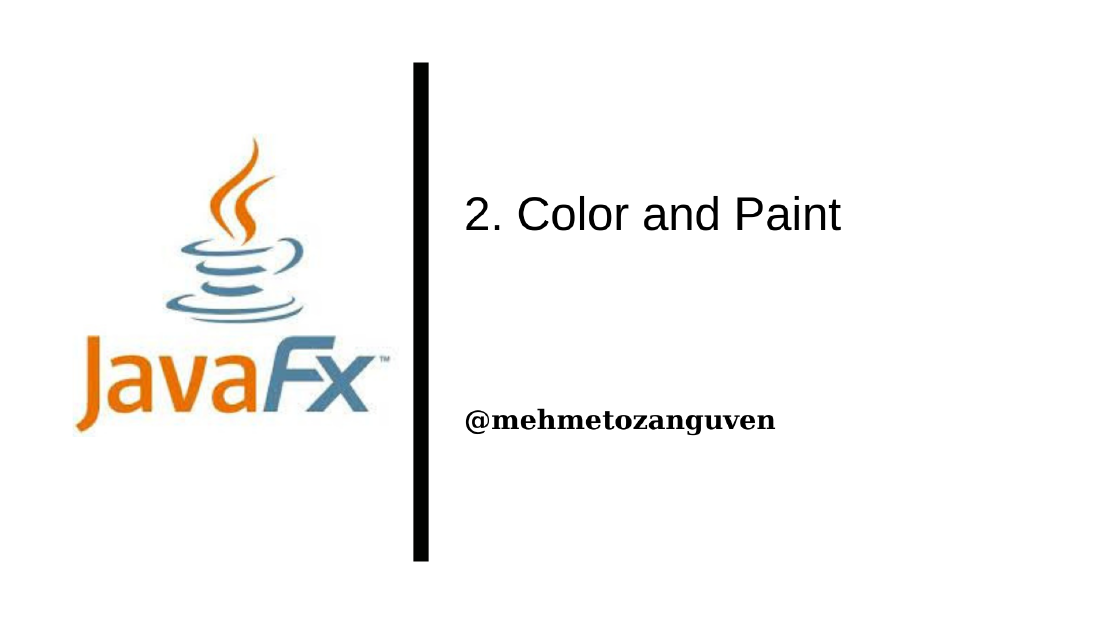
JavaFX Canvas and GraphicsContext
The screen of a computer is a grid of little squares called pixels. The color of each pixel can be set individually, and drawing on the screen just …

In JavaFX, events are represented by objects. When an event occurs, system collects all the information relevant to the event and construct an object to contain that information.
Different types of events are represented by different objects. For instance mouse events are represented by MouseEvent object.
After the event object is constructed, it can be passed as a parameter to a designated method. That method is called an event handler. In JavaFX, event handler are generally written as functional interface.
Even if you don’t care about, there are actually many processes to handle event. System handles these processing stuff. However you should (or must) know that there is a kind of a loop which does the following:
while the program is still running: Wait for the next event to occur Handle the eventThis loop is called an event loop. Every GUI program has an event loop. In Java, you don’t have to write the loop. System will handle it.
To act on the event, a program must detect the event. In order to detect an event, the program must listen for it. Listening can be done by registering an event listener
For many kinds of events in JavaFX, listeners are defined by the functional interface called EventHandler (which defines the method handle(event))
When you provide a definition for the
handle(event)method, you write the code that will be executed to handle the event
Here is the example for registration for an event:
helloButton.setOnAction(e -> message.setText("something"));
/*
When the user click the button, an event of type ActionEvent` is generated.
The target of that event is the helloButton
The method helloButton.setOnAction() registers an event listener which will receive notification of any ActionEvent from the button
*/
Also handler can consume an event which basically stops the any further handling of the event. For instance:
@Override
public void start(Stage primaryStage) {
Rectangle rect = new Rectangle(50, 50);
StackPane root = new StackPane(rect);
rect.addEventFilter(MouseEvent.MOUSE_CLICKED, evt -> {
System.out.println("rect click(filter)");
// evt.consume();
});
root.addEventFilter(MouseEvent.MOUSE_CLICKED, evt -> {
System.out.println("root click(filter)");
// evt.consume();
});
root.setOnMouseClicked(evt -> {
System.out.println("root click(handler)");
// evt.consume();
});
rect.setOnMouseClicked(evt -> {
System.out.println("rect click(handler)");
// evt.consume();
});
Scene scene = new Scene(root, 200, 200);
primaryStage.setScene(scene);
primaryStage.show();
}
When you click on rect , the event handling starts at the root Node .In this case filter will be called. If the event is not consumes in the filter, it is then passed to the rect Node. If that filter also doesn’t consume the event, then it is passed to the event handler of the rect . If you want to stop this movement, you can just uncomment the evt.consume in any stage.
To register a mouse event is actually same as the registration of the button action. It would be good to know that there are many mouse events:
c.setOnMouseMoved(handler)MouseEntered , generated when the mouse cursor moves from outside a component into the component.MouseExited, generated when the mouse cursor moves out of the component.MousePressed, generated when one of button pressed on the mouse.MouseReleased , generated when the user releases one of the buttons on the
mouseMouseClicked, generated after a mouse released event if the user pressed and released
the mouse button on the same componentMouseDragged, generated when the user moves the mouse while holding down a mouse buttonMouseMoved, generated when the user moves the mouse without holding down a button.User can hold down certain modifier keys while using the mouse. The possible modifier keys could be: the shift key, the control key etc.. You can respond to an event according to the modifier key. Examples:
evt.isShiftDown(), evt.isControlDown(), evt.isAltDown()
You can also want to return different responses according to the pressed button on the mouse. For instance you can listen only left button of the mouse, or middle etc.. If you want to know which button was pressed or released, you can call this method: evt.getButton() which returns one of the enumerated values: MouseButton.PRIMARY, MouseButton.MIDDLE, or MouseButton.SECONDARY
// In this example, if the user pressed mouse on the canvas without pressing shiftkey, rectangle will be drawn with red color, otherwise rectangle will be blue color
canvas.setOnMousePressed(evt -> {
GraphicsContext g = canvas.getGraphicsContext2D();
if (evt.isShiftDown()) {
g.setFill(Color.BLUE);
g.fillOval(...)
} else {
g.setFill(Color.RED);
g.fillOval(...)
}
});
This is kind of a basic event. This event is used to drive an animation. The event in this case happen in the background, and you don’t have to register a listener to respond to them. Only you need to write a method that will be called by the system when the event occurs.
A computer animation is just a sequence of images, presented to the user one after the other. If the time between images is short, and if the change from one image to another is not too great, then the user perceives continuous motion.
In JavaFX, you can program an animation using an object of type AnimationTimer . You can run the animation with animation.start() and stop it via animation.stop()
Animation has a method called handle(time) , but this is not the method that you call, it’s one that you need to write to say what happens in the animation. The system will call your handle() method.
The handle() method will be called on the JavaFX application thread. Since JavaFX animations are meant to run at 60 frames per second, which means handle() will ideally be called every 1/60 second.

The screen of a computer is a grid of little squares called pixels. The color of each pixel can be set individually, and drawing on the screen just …

Color Computer color uses an RGB color system which means that color on the a computer screen is specified by three numbers called color components, …